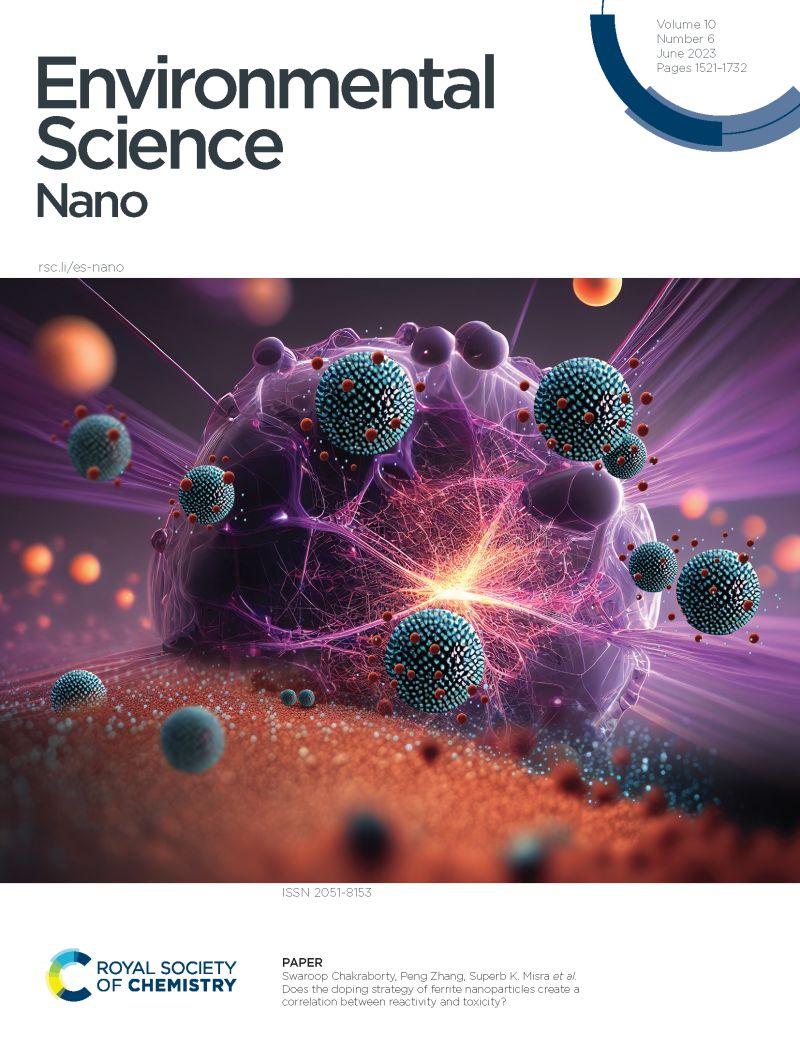风化和模拟胃液暴露对细胞对聚苯乙烯颗粒反应的影响
IF 5.8
2区 环境科学与生态学
Q1 CHEMISTRY, MULTIDISCIPLINARY
引用次数: 0
摘要
微塑料对环境构成了日益严重的威胁,对人类健康产生了复杂的影响。尽管对微塑料的细胞毒性进行了广泛研究,但在了解细胞对环境风化和生理过程之间相互作用的反应方面仍存在差距。本研究旨在通过评估和比较体外细胞对原始聚苯乙烯颗粒、在去离子水和海水中紫外线照射下风化的颗粒以及随后在模拟胃液(SGF)中培养的颗粒的反应,填补这一知识空白。在这项研究中,采用了衰减全反射模式的傅立叶变换红外光谱(ATR-FTIR)、拉曼光谱、X 射线光电子能谱(XPS)和扫描电子显微镜-能量色散光谱(SEM-EDS)来对颗粒进行表面化学和形态表征。结合这些技术,可以全面了解风化降解和 SGF 培养导致的表面形态和化学变化。结果表明,风化颗粒上形成了氮和羰基,海水风化颗粒的风化程度更明显。经过 SGF 培养后,风化颗粒表面检测到了更强的氮和酰胺基团,并附着了更多的有机物。研究人员使用了两种广泛用于评估微塑料细胞毒性的细胞系:RAW264.7 巨噬细胞和 Caco-2 肠上皮细胞。结果表明,与原始颗粒相比,经风化和 SGF 处理的颗粒增强了巨噬细胞的活力和促炎效应。所有颗粒组都检测到活性氧(ROS)生成增加。风化颗粒对 Caco-2 细胞产生了更高的细胞毒性效应,并破坏了紧密连接的完整性。SGF 培养形成的有机物保护了紧密连接的完整性并降低了细胞毒性。这些发现突出表明,要更全面地评估微塑料的毒性,必须同时考虑环境和生理因素。本文章由计算机程序翻译,如有差异,请以英文原文为准。
Effects of Weathering and Simulated Gastric Fluid Exposure on Cellular Responses to Polystyrene Particles
Microplastics pose a growing environmental threat with complex implications for human health. Despite the extensive research on the cytotoxicities of microplastics, gaps remain in understanding cellular responses to the interplay between environmental weathering and physiological processes. This study aims to fill this knowledge gap by evaluating and comparing the in vitro cellular responses to pristine polystyrene particles, particles weathered under UV light in DI water and seawater, and particles with subsequent incubation in simulated gastric fluid (SGF). In this study, Fourier transform infrared spectroscopy in attenuated total reflection mode (ATR-FTIR), Raman spectroscopy, X-ray photoelectron spectroscopy (XPS), and scanning electron microscopy-energy dispersive spectroscopy (SEM-EDS) were implemented to conduct surface chemistry and morphology characterizations of the particles. The combination of these techniques allowed a comprehensive understanding of surface morphology and chemistry alterations due to the weathering degradation and SGF incubation. Results showed nitrogen and carbonyl groups formed on weathered particles, and seawater-weathered particles showed a more pronounced weathering degree. After SGF incubation, stronger nitrogen and amide groups were detected on the surface of weathered particles, and more organic matter was attached. Two cell lines that are widely used for the evaluation of microplastic cytotoxicity were used, RAW264.7 macrophage and Caco-2 intestine epithelial cells. Results showed weathered and SGF-treated particles enhanced macrophage viability and pro-inflammatory effects compared to pristine particles. Elevated reactive oxygen species (ROS) generation was detected for all particle groups. Weathered particles caused higher cytotoxicity effects on Caco-2 cells and damaged tight junction integrity. The organic matter formation from the SGF incubation protected tight junction integrity and reduced cytotoxicity. These findings highlight the importance of taking both environmental and physiological factors into account for a more comprehensive assessment of microplastic toxicity.
求助全文
通过发布文献求助,成功后即可免费获取论文全文。
去求助
来源期刊

Environmental Science: Nano
CHEMISTRY, MULTIDISCIPLINARY-ENVIRONMENTAL SCIENCES
CiteScore
12.20
自引率
5.50%
发文量
290
审稿时长
2.1 months
期刊介绍:
Environmental Science: Nano serves as a comprehensive and high-impact peer-reviewed source of information on the design and demonstration of engineered nanomaterials for environment-based applications. It also covers the interactions between engineered, natural, and incidental nanomaterials with biological and environmental systems. This scope includes, but is not limited to, the following topic areas:
Novel nanomaterial-based applications for water, air, soil, food, and energy sustainability
Nanomaterial interactions with biological systems and nanotoxicology
Environmental fate, reactivity, and transformations of nanoscale materials
Nanoscale processes in the environment
Sustainable nanotechnology including rational nanomaterial design, life cycle assessment, risk/benefit analysis
 求助内容:
求助内容: 应助结果提醒方式:
应助结果提醒方式:


